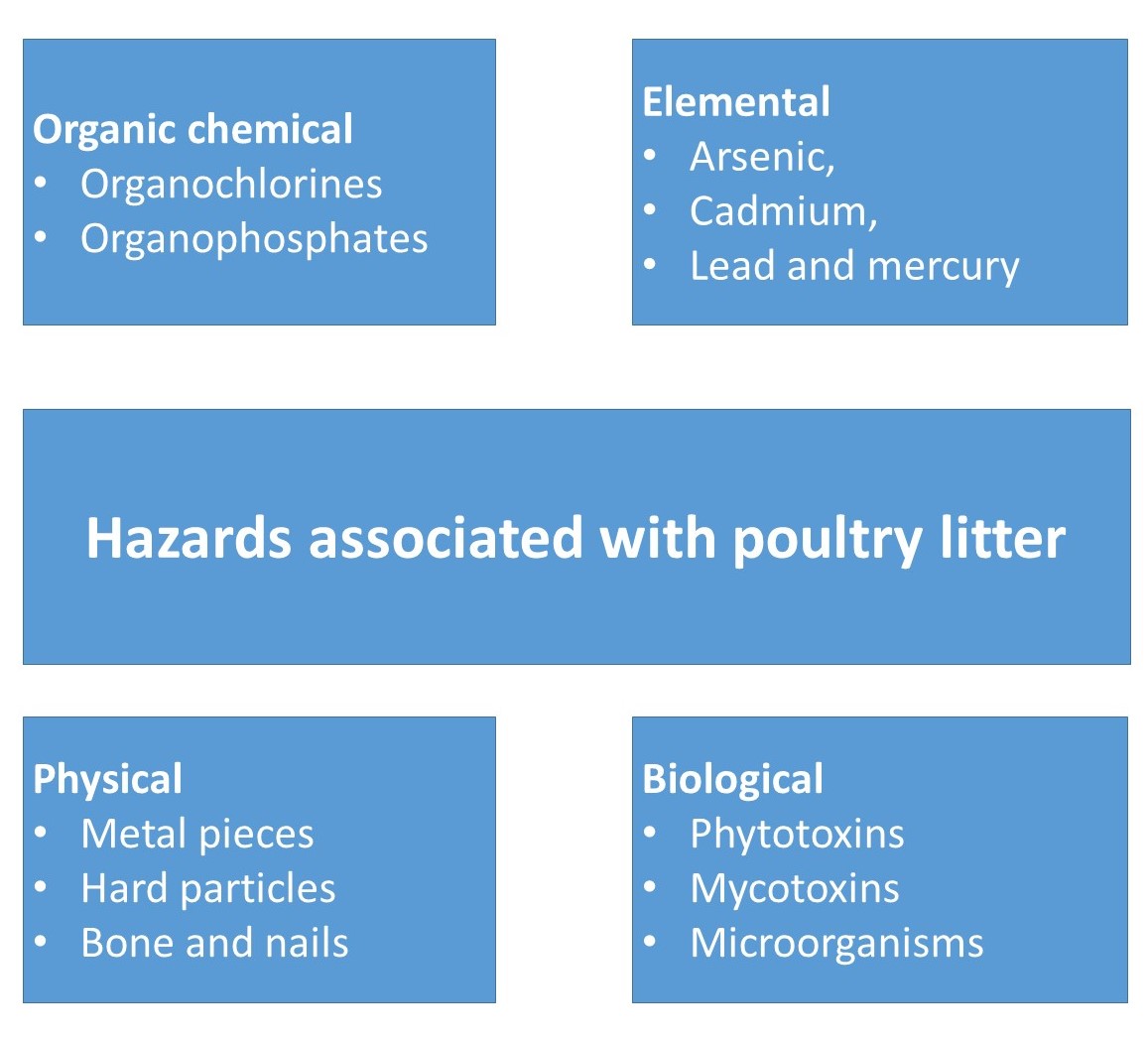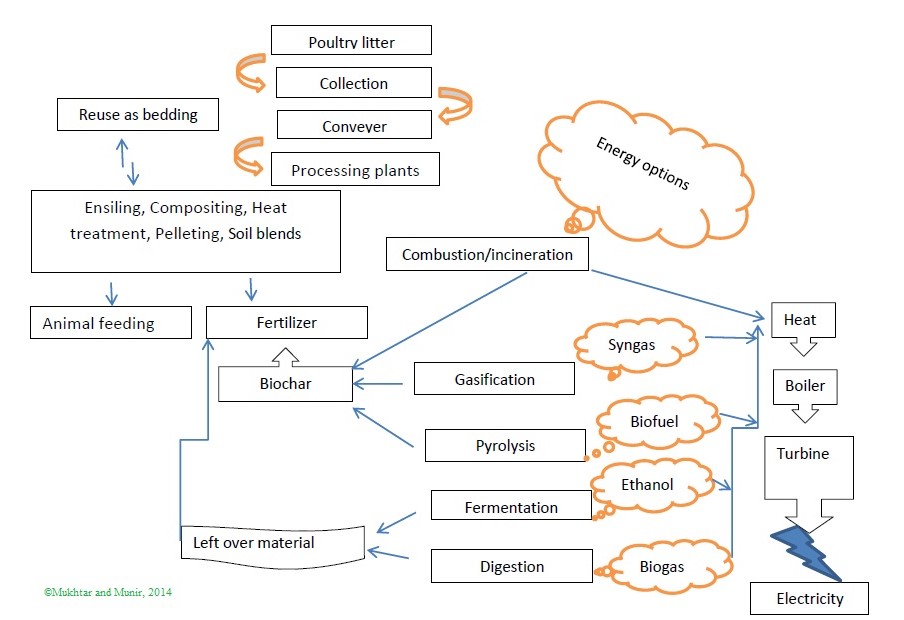
| Version | Summary | Created by | Modification | Content Size | Created at | Operation |
|---|---|---|---|---|---|---|
| 1 | Muhammad Tanveer Munir | + 723 word(s) | 723 | 2020-05-08 17:37:20 | | | |
| 2 | Catherine Yang | Meta information modification | 723 | 2020-07-13 08:09:23 | | | | |
| 3 | Vicky Zhou | -1 word(s) | 722 | 2020-10-29 09:17:56 | | | | |
| 4 | Muhammad Tanveer Munir | + 252 word(s) | 974 | 2020-12-11 13:32:33 | | | | |
| 5 | Muhammad Tanveer Munir | Meta information modification | 974 | 2020-12-27 15:05:24 | | |
Video Upload Options
Poultry litter is a combination of aviary excreta and bedding materials such as wood shavings, sawdust, peanut hulls, shredded sugar cane, straw, or other dry, absorbent, uneaten feed, broken eggs, dead birds, bird feathers and low-cost organic material [1].
1. Introduction
The poultry industry is the fastest expanding agriculture sector [1]. The growth of this sector is also increasing the waste products linked to production operations [2]. The main waste product is "poultry litter" which mainly contains the bedding material and bird droppings [3]. Although large quantities of poultry litter are being produced in poultry farms, there are limited disposal options. The direct open land spread or dumping can lead to problems of greenhouse gasses emission, water quality issues, pathogenic hazards. Therefore, treating poultry litter (for reuse or energy production) could reduce these problems.
The global poultry production is increasing day by day. About 111,000 thousand metric tons of poultry were produced in 2015. These numbers are expected to increase by 24% taking the total production of 131,255 thousand metric tons in 2025 [4]. Likewise, poultry litter generation is also increasing. The poultry litter should be disposed of properly because of the following risks:
- Excess nutrient in the soil due to land application
- Contamination of drinking water
- Eutrophication of surface waters
- Ammonia emission from poultry houses
- Soil acidification through nitrification and leaching
- Biosecurity concerns
- Transmission of disease-causing pathogens
The price paid for poultry litter buying varies according to distance from the plant, litter quality, litter moisture content, and time of year. Poultry litter is collected after one or more flock removal. It is collected to carry out of the shed and can be transported to processing plants that may be inside the farm or outside at a distance. Poultry litter after collection is conveyed to plants where it can be processed or decomposed.
2. Hazards Associated with Poultry Litter
There are various hazards associated with poultry litter and they can be categorized into four categories (Figure 1):

During the usage life of litter, they mainly affect the health of birds and the farmworkers and sometimes the environment in form of emissions, for example, ammonia emission influences all [5].
The nutrition of birds is mostly associated with what we find in litter and the other factors can be the environment and substrate material [6][7][8]. If the diet is heavy in hazardous substances such as dioxins, that will also be present in the litter and further utilization would be impacted by this hazard [4]. Such contaminants may not affect the health of birds being raised on litter but the after uses could be risky. Meanwhile, when the litter burned, the ash contains a concentrated amount of heavy metals that are can transfer to soil and ultimately leech into freshwater bodies [9]. The presence of chemical contaminants, for example, wood polishing and joining materials, could be a chemical hazard to the people, birds and environment when exposed [10].
The biological hazards associated with poultry litter could be responsible for various infections in the birds [11][12][13] and can transmit zoonotic diseases if they contaminate the food supply chain [14]. Some treatment options such as ionization, compositing and burning can reduce or eliminate this hazard [14].
The presence of physical objects such as nails and feather parts can cause injuries to birds or animals if this material is reused as bedding [10].
3. Uses of Poultry Litter
The poultry litter can be used in a number of ways as shown in Figure 2.
Figure 2. Potential uses of poultry litter.
3.1. Direct Applications
The main and conventional use of poultry litter is to use for land application as fertilizer [15]. The recent price hike of commercial fertilizer has created a demand for poultry litter as fertilizer [16]. It is rich in nutrients like phosphorus and nitrogen, so it is very suitable for lands that are deficient in nitrogen and phosphorus [2]. Another direct use of poultry litter is the fertilization of fish ponds in order to promote algal growth [17].
These applications can result in a disturbance of the water quality by leaching and nutrient loading, transmitting pathogens [2]. Certain type of drug residues, heavy metals and hormones are present in poultry litter those may affect the living bodies [5].
3.2. Conversion into Value Added Products
The composting of litter produces a valuable fertilizer that can be used in land applications as mentioned above [15]. It has also been used to make pellets, ruminant ration [18] and soil blends for pottery [9]. Compositing also generates heat at about 60°C and can be used to warm the water and heat the farms.
The Poultry litter with certain modifications can be fed to animals as a crude protein source [18]. However, some countries have banned this practice owing to biosafety concerns [19] [18][17][15]. In practice, it is either directly fed to animals or used in ensiling along with fodder [18].
Raw and composted poultry litter can be used to make pellets that are concentrated in nutrients and have slow release. This process makes handling, transport and usage easier. Pelleting is done by heating and compressing and the resultant pellets can be sued as fertilizer, soil amendment, feed additive, or energy fuel [20].
Apart from the above-mentioned options, the reuse of poultry litter is always an economical option. The reuse can be made possible by composting or using some physical (heating and drying) or chemical treatment (acidifiers) [21]. However, the final result is again the waste product.
3.3. Energy Production from Poultry Litter
The current environmental crisis and depletion of fossil fuels require alternative energy sources, the poultry litter could be a substrate to be converted into clean energy by eco-friendly options e.g. anaerobic digestion, combustion, pyrolysis, gasification and fermentation [22]. Many poultry production farms are using poultry litter to fulfill their energy needs [16]. It not only eliminates the problem of waste management but also makes them self sufficient in energy production. The energy is basically produced in form of gasses or liquid fuels or as a by-product of decomposition [16].
References
- Mariusz Tańczuk; Robert Junga; Alicja Kolasa-Wiecek; Patrycja Niemiec; Assessment of the Energy Potential of Chicken Manure in Poland. Energies 2019, 12, 1244, 10.3390/en12071244.
- Margaret Kyakuwaire; Giregon Olupot; Alice Amoding; Peter Nkedi-Kizza; Twaha Ateenyi Basamba; Nkedi- Kizza; How Safe is Chicken Litter for Land Application as an Organic Fertilizer? A Review. International Journal of Environmental Research and Public Health 2019, 16, 3521, 10.3390/ijerph16193521.
- Global industry statistics . Poultry Hub. Retrieved 2020-12-11
- Muhammad Irfan; Nasir Mukhtar; Tanveer Ahmad; Muhammad Tanveer Munir; Gastric impaction: an important health and welfare issue of growing ostriches. Agricultura Tropica et Subtropica 2020, 53, 161-173, 10.2478/ats-2020-0016.
- Adriana Nowak; Katarzyna Matusiak; Sebastian Borowski; Tadeusz Bakuła; Sebastian Opaliński; Roman Kołacz; Beata Gutarowska; Cytotoxicity of Odorous Compounds from Poultry Manure. International Journal of Environmental Research and Public Health 2016, 13, 1046, 10.3390/ijerph13111046.
- Iqbal, A.; Javed, M. T.; Hassan, M.; Khan, I. A.; Munir, M. T.; Serobiochemical changes induced by various concentrations of ethanol through drinking water in broiler chicks. Veterinaria 2015, 3(1), 18-21.
- Rehman, Z.U.; Munir, M.T.; Effect of garlic on the health and performance of broilers. Veterinaria 2015, 3(1), 32-39.
- Munir, M.T; Javed, M.T; Rehman, A; Reyes-Reyes, J.D.; Effects of ethanol on health and performance of poultry . World's Poultry Science Journal 2021, 77, 5, 10.1080/00439339.2020.1866962.
- Nanthi S. Bolan; Ariel A Szogi; Thammared Chuasavathi; Balaji Seshadri; Michael J Rothrock; P. Panneerselvam; Uses and management of poultry litter. World's Poultry Science Journal 2010, 66, 673-698, 10.1017/s0043933910000656.
- Muhammad Tanveer Munir; C. Belloncle; M. Irle; M. Federighi; Wood-based litter in poultry production: a review. World's Poultry Science Journal 2019, 75, 5-16, 10.1017/s0043933918000909.
- Khaled Kaboudi; Sajid Umar; Muhammad Tanveer Munir; Prevalence of Coccidiosis in Free-Range Chicken in Sidi Thabet, Tunisia. Scientifica 2016, 2016, 1-6, 10.1155/2016/7075195.
- Riaz, A.; Umar, S.; Munir, M. T.; Tariq, M.; Replacements of antibiotics in the control of necrotic enteritis: a review. The Science Letters 2017, 5(3), 205-216.
- Khaled Kaboudi; Ahmed Rejeb; Moncef Bouzouaia; Muhammad Tanveer Munir; Umar Sajid; Outbreak of Respiratory Aspergillosis in Backyard Duck Flock in Tunisia. International Journal of Livestock Research 2018, 8, 361, 10.5455/ijlr.20170717090407.
- Munir, M.T.; Federighi, M; Control of Foodborne Biological Hazards by Ionizing Radiations. Foods 2020, 9, 878, 10.3390/foods9070878.
- Nanthi Bolan; A.A. Szogi; T. Chuasavathi; B. Seshadri; M.J. Rothrock; P. Panneerselvam; Uses and management of poultry litter. World's Poultry Science Journal 2010, 66, 673-698, 10.1017/s0043933910000656.
- Harish Kumar Jeswani; Andrew Whiting; Alastair Martin; Adisa Azapagic; Environmental and economic sustainability of poultry litter gasification for electricity and heat generation. Waste Management 2019, 95, 182-191, 10.1016/j.wasman.2019.05.053.
- Nagham Elsaidy; Fatma Abouelenien; Ghada A.K. Kirrella; Impact of using raw or fermented manure as fish feed on microbial quality of water and fish. The Egyptian Journal of Aquatic Research 2015, 41, 93-100, 10.1016/j.ejar.2015.01.002.
- M. A. Belewu; Subject Review Article: Broiler litter as feed for ruminants - Potential and limitations under Nigerian Conditions. Ghana Journal of Agricultural Science 1997, 30, 79-85, 10.4314/gjas.v30i1.1981.
- Chicken litter feeding ban . Queensland Government. Retrieved 2020-12-27
- J. McMullen; O. O. Fasina; C. W. Wood; Y. Feng; Storage and handling charecteristics of pellets from poultry litter. Applied Engineering in Agriculture 2005, 21, 645-651, 10.13031/2013.18553.
- Victor Fernando Buttow Roll; M.A. Dai Prá; A.P. Roll; Research on Salmonella in broiler litter reused for up to 14 consecutive flocks. Poultry Science 2011, 90, 2257-2262, 10.3382/ps.2011-01583.
- Muhammad Tanveer Munir; Michel Federighi; Control of Foodborne Biological Hazards by Ionizing Radiations. Foods 2020, 9, 878, 10.3390/foods9070878.





